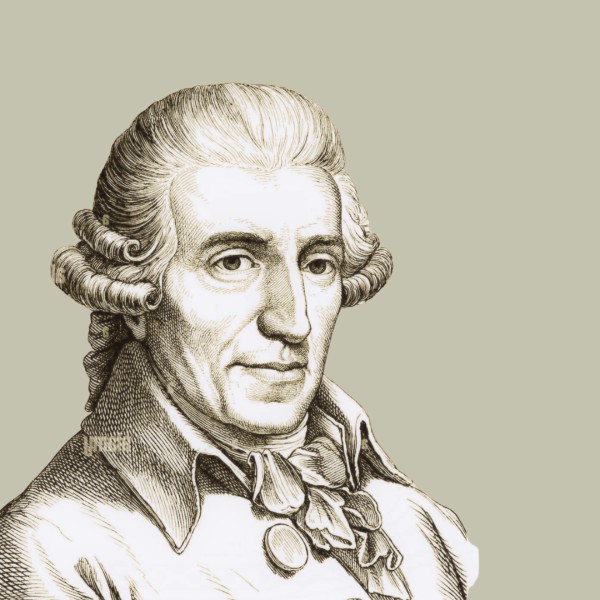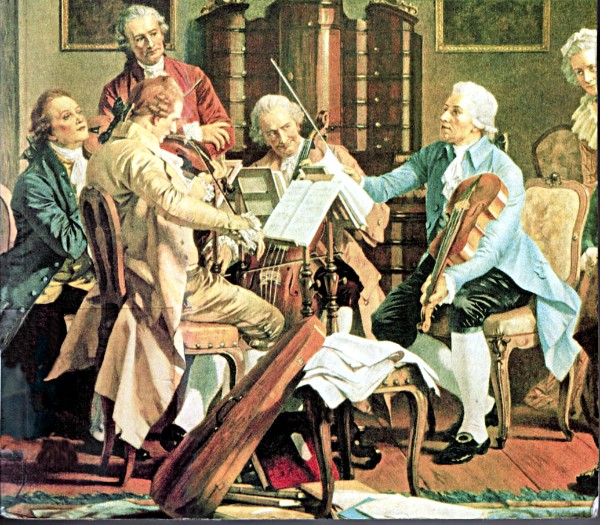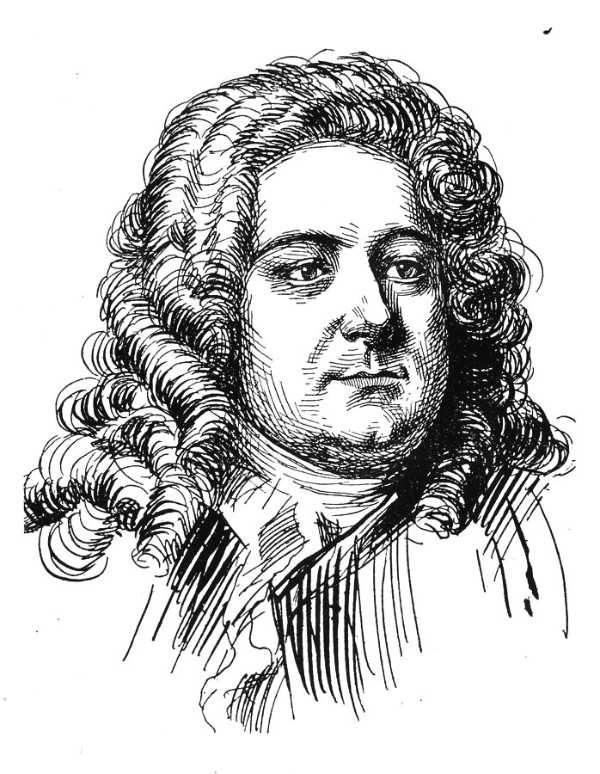The 68 string quartets by Joseph Haydn revolutionised chamber music and earned him the title “Father of the String Quartet.” Haydn transformed the genre from polite parlour tunes into a dynamic conversation among four instruments.

Joseph Haydn
Written primarily between the 1750s and 1790s, these works showcase his ingenuity, featuring sparkling melodies, intricate counterpoint and really clever structural surprises.
Drawing from Haydn’s extensive catalogue is no easy task, but we’ve selected 10 of Haydn’s most ingenious string quartets. That selection is based on their musical inventiveness, historical significance, and influence on subsequent generations of composers.
So let’s get started with his Op. 20 set of string quartets, representing Haydn’s early experiments that defined the conversational nature of the genre.
String Quartet in D Major, Op. 20, No. 4, Hob. III:34 (1772)
The six “Sun” quartets of 1772 shook up the classical music world in 1772. Haydn was in his late 30s and working for the Esterházy family. The Op. 20 quartets came at a time when Haydn was pushing boundaries, blending the elegance of the gallant style with the emotional depth of the “Sturm und Drang” literary movement.
Op. 20 No. 4 was written for four skilled players, so Haydn could be adventurous. He treated all four instruments, two violins, viola, and cello, like equal partners. This was pretty radical as the first violin would normally hog the spotlight.
This quartet is not a solo act, but a conversation. It’s funny, tender, and clever all at once. It’s like friends jamming together, trading ideas and laughs. This quartet is the perfect entry point in the wonderful and human world of Joseph Haydn.
String Quartet in F Minor, Op. 20, No. 5, Hob. III:35 (1772)
Compared to the sunny D-Major quartet, the Op. 20 No. 5 in F minor has a darker and more introspective character. It reflects the “storm and stress” trend at the time, putting a premium on dramatic and emotional intensity.
The opening movement is especially intense, unfolding from a brooding theme through a number of intricate motivic developments. There is plenty of lyrical melancholy in the slow movement, and just listen to the double fugue in the finale. After all, Haydn was a master of counterpoint.
This timeless gem is so emotionally rich. It is a musical journey through tension, calm, and eventual revolution. And you certainly need expert musicians to bring out the raw energy and nuance, mixing depth and accessibility.
String Quartet in E-flat Major, Op. 33, No. 2, Hob. III:38, “Joke” (1781)
The Opus 20 quartets turned Haydn into a superstar in the musical world. One decade later, he further refined the genre with more polish and playfulness in his Op. 33 set. As Haydn himself said, these works were written in “a new and special way.”
The Op. 33 are often called the “Russian” quartets, because they are dedicated to the Grand Duke Paul of Russia. Some scholars theorise that these quartets might have been the inspiration for the six Mozart string quartets dedicated to Haydn.
The most famous of the set earned the nickname “Joke” because of the mischievous ending of the Finale. However, the entire quartet is packed with Haydn’s trademark humour and surprises. It is light-hearted yet sophisticated, showcasing the composer’s ability to make complex music feel effortless. Just goes to show that classical music does not have to be deadly serious.
String Quartet in G Major, Op. 33, No. 5, Hob. III:41 (1781)
Another gem from the Op. 33 set is the quartet No. 5 in G Major. It sometimes carries the nickname “How Do You Do?” for its quirky and conversational opening. This quartet presents a perfect blend of elegance, wit, and warmth.
Haydn called the Op. 33 “new and special,” likely because of their polished structure, lyrical themes, and the equal roles for all four instruments. Each movement has its own character, from the musical handshake of the opening to the warm and lyrical slow movement. The Scherzo is a lively dance with a rustic edge, and the Finale is a set of variations on a simple and catchy tune with folk-song character.
Op. 33 No. 5 is a crowd pleaser because of its sunny glow, catchy themes, and some subtle humour. It’s a perfect blend of sophistication and fun, full of infectious energy and momentum.
String Quartet in D Major, Op. 64, No. 5, Hob. III:63, “The Lark” (1790)
Nicknamed “The Lark” for its soaring and birdlike melody in the opening movement, the string quartet Op. 64, No. 5 represents a polished example of Haydn’s ability to blend the emotional depth of his earlier works with a polished and accessible style that greatly appealed to audiences.
This quartet is less experimental than his Op. 20 but more refined than Op. 33, showcasing Haydn’s mastery of balance. We find catchy tunes, a tight structure, and it’s a performer’s delight and a listener’s joy.
Each movement has its own personality, from the chatting bird in the opening to a slow movement of pure warmth. The minuet has a playful spin, and the high-energy Finale is like a musical game of hot potato. It certainly sparkles with clarity and charm.
String Quartet in D Minor, Op. 76, No. 2, Hob. III:76, “Fifths” (1797)
The six quartets of Op. 76 are ambitious late works with advanced forms and thematic unity. Composed in 1797, they are among Haydn’s final and most celebrated contributions to the genre.
At the age of 65, Haydn was a global superstar, having returned from his triumphant tours to London. This trip had given him new ideas, and he now blended technical brilliance, emotional depth, and a highly polished style that appealed to both players and audiences. And the Op. 76 No. 2 is a masterpiece, bold, emotional, and packed with Haydn’s wit and wisdom.
Nicknamed “Fifths” for the stark and descending fifth motif in the opening movement, the work opens with a tense and conversational energy. The warm D Major in the slow movement provides a lyrical and playful breather, but the Menuetto is back in the minor key. Sometimes it is nicknamed the “Witches Minuet.” The Finale is a whirlwind based on a fiery, folk-inspired theme.
String Quartet in C Major, Op. 76, No. 3, Hob. III:77, “Emperor” (1797)
Nicknamed “Emperor” for its majestic second movement, Op. 76 No. 3 is one of Haydn’s finest works in the genre. It is a masterpiece of balance, juggling grand, lyrical and humorous elements in a clear and approachable style.
The “Emperor” nickname comes from the second movement, a set of variations on Haydn’s anthem “God Save Emperor Francis,” composed in 1797 as a patriotic response to Napoleon’s rise. The simple and noble melody undergoes four variations that transform the theme while keeping its dignity completely intact.
The opening movement is a burst of energy, sounding a bold and fanfare-like theme in the first violin. And just listen to the sudden pauses, harmonic twists, and playful interplay between all four instruments. The minuet has a rustic edge while the Finale is once more a high-octane affair.
String Quartet in B-flat Major, Op. 76, No. 4, Hob. III:78, “Sunrise” (1797)
Another gem in the Op. 76 set is the string quartet in B-flat Major, No. 4. It earned the nickname “Sunrise” from the opening of the first movement. A soaring violin melody rises over a gentle accompaniment, resembling the sun peeking over the horizon.
It is a magical moment that sets a joyful tone. The mood quickly turns playful with a bouncy second theme and lively interplay between the four instruments. The slow movement, in turn, is a soulful gem, with a tender and hymn-like melody that is almost orchestral in texture. Intimate and heartfelt, it provides a moment of quiet reflection.
The minuet is again a rustic dance with Haydn adding quirky offbeat accents and dynamic shifts to keep it cheeky. What a charming mix of elegance and earthiness. And then there is the infectious rhythm of the rollicking Finale. Op. 76 No. 4 is a work of sheer beauty and charm, blending accessibility with sophistication.
String Quartet in D Major, Op. 76, No. 5, Hob. III:79 (1797)
Op. 76, No. 5 in D Major is a radiant and lyrical work that is often considered among Haydn’s finest string quartets. Known for its serene and songlike qualities, this quartet does not have a catchy nickname, but its warmth and elegance make it a standout.
It is a gem for its lyrical and balanced structure, and certainly more introspective and serene. The sunny D Major feels like a warm embrace, and Haydn once again blends sophistication with charm and vibrant energy.
The heart of this quartet is the deeply expressive slow movement scored in the unusual key of F-sharp Major. Sounding a unique and glowing warmth, the melody is soulful and expansive, with a touch of melancholy. It’s like a private confession, both tender and profound. On account of this movement, some commentators have called it the “Graveyard Quartet.”
String Quartet in G Major, Op. 77, No. 1, Hob. III:81 (1799)

Haydn playing a string quartet
Let us conclude this blog on the 10 most ingenious string quartets by Joseph Haydn by featuring his Op. 77, No. 1. It represents a vibrant and polished work that sounds the culmination of Haydn’s quartet writing.
This work was among his final contributions to the genre he helped to perfect. This quartet is the culmination of his craft, blending the emotional depth of his late style, the polish of his London visits, and his lifelong love of surprise and interplay.
The opening movement presents a flowing theme in the first violin contrasted by a dance-like second theme. The slow movement is a lyrical gem, and the minuet is full of musical mischief. The folk-inspired theme of the Finale is passed among the quartet like a musical relay, and the high-spirited finish simply makes us smile.
Joseph Haydn mastered the string quartet genre by transforming it into a dynamic and conversational form where all four instruments share equal roles. From the Op. 20 to the Op. 77, he blends structural brilliance with emotional depth and incredible humour. Haydn set the standard for the quartets of Mozart, Beethoven, and beyond.
For more of the best in classical music, sign up for our E-Newsletter

